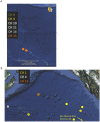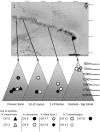Comparing molecular variation to morphological species designations in the deep-sea coral Narella reveals new insights into seamount coral ranges
- PMID: 23029093
- PMCID: PMC3459954
- DOI: 10.1371/journal.pone.0045555
Comparing molecular variation to morphological species designations in the deep-sea coral Narella reveals new insights into seamount coral ranges
Abstract
Recent studies have countered the paradigm of seamount isolation, confounding conservation efforts at a critical time. Efforts to study deep-sea corals, one of the dominant taxa on seamounts, to understand seamount connectivity, are hampered by a lack of taxonomic keys. A prerequisite for connectivity is species overlap. Attempts to better understand species overlap using DNA barcoding methods suggest coral species are widely distributed on seamounts and nearby features. However, no baseline has been established for variation in these genetic markers relative to morphological species designations for deep-sea octocoral families. Here we assess levels of genetic variation in potential octocoral mitochondrial barcode markers relative to thoroughly examined morphological species in the genus Narella. The combination of six markers used here, approximately 3350 bp of the mitochondrial genome, resolved 83% of the morphological species. Our results show that two of the markers, ND2 and NCR1, are not sufficient to resolve genera within Primnoidae, let alone species. Re-evaluation of previous studies of seamount octocorals based on these results suggest that those studies were looking at distributions at a level higher than species, possibly even genus or subfamily. Results for Narella show that using more markers provides haplotypes with relatively narrow depth ranges on the seamounts studied. Given the lack of 100% resolution of species with such a large portion of the mitochondrial genome, we argue that previous genetic studies have not resolved the degree of species overlap on seamounts and that we may not have the power to even test the hypothesis of seamount isolation using mitochondrial markers, let alone refute it. Thus a precautionary approach is advocated in seamount conservation and management, and the potential for depth structuring should be considered.
Conflict of interest statement
Figures





References
-
- Hubbs CL (1959) Initial discoveries of the fish faunas on the seamounts and offshore banks of the eastern pacific. Pac Sci 13: 311–316.
-
- Wilson RR, Kaufmann RS (1987) Seamount biota and biogeography. In: Keating BH, et al..., editors. In Seamounts, Islands and Atolls. Washington, D.C.: American Geophysical Union. 355–377.
-
- Parker T, Tunnicliffe V (1994) Dispersal strategies of the biota on an oceanic seamount: Implications for ecology and biogeography. Biol Bull Mar Biol Lab Woods Hole 187(3): 336–345. - PubMed
-
- Rogers AD, Blaxter JHS, Southward AJ (1994) The biology of seamounts. Advances in Marine Biology. : Academic Press. 305–350.
-
- Parin NV, Mironov AN, Nesis KN (1997) Biology of the Nazca and Sala y Gomez submarine ridges, an outpost of the Indo-West Pacific fauna in the eastern Pacific Ocean: Composition and distribution of the fauna, its communities and history. Adv Mar Biol 32: 145–242.
Publication types
MeSH terms
Substances
LinkOut - more resources
Full Text Sources

